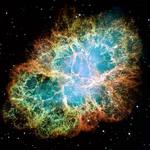How we're listening for the Big Bang
 Physics Physics
University of Adelaide researchers are among a large international team of physicists taking part in one of the most challenging scientific endeavours ever undertaken: the attempt to directly detect vibrations in space called gravitational waves. The international team's latest research findings, published recently in the journal Nature, are considered to be a small but significant step forward in the quest to better understand the nature of the universe after the Big Bang. Gravitational waves, which previously have only indirectly been shown to exist, are believed to be emitted whenever mass is accelerated. Physicists expect these waves to provide a whole new method for observing and understanding the universe, including gathering information about the Big Bang. Current detectors operate in the audio frequency range, which in simple terms means that scientists are trying to detect gravitational waves by "listening" to the universe. "One of the goals of the team's research is the direct detection of black holes - to listen to their births and the 'ring-tones' produced by their vibrations," said Professor Jesper Munch, Chairman of the Australian Consortium for Gravitational Astronomy (ACIGA) and Professor of Experimental Physics at the University of Adelaide. "Another goal is to listen to the birth of the universe itself, called the 'stochastic background', which should sound a bit like wind in the treetops." ACIGA includes research groups at the University of Adelaide, ANU, Melbourne, Monash, UWA and Charles Sturt University. Researchers from these six Australian universities are working with a large international team from more than 70 universities in the United States, Europe, Australia and Asia, using the huge detectors of the Laser Interferometer Gravitational Observatory (LIGO) and the Italian-French VIRGO. The detectors use powerful lasers, and mirrors suspended at the ends of multi-kilometre scale vacuum pipes, to sense the tiny vibrations of gravity waves. The LIGO observatories are located in Washington State and Louisiana in the US and VIRGO close to Pisa in Italy. In its Nature paper, the international team announced its first significant observations relating to waves from the Big Bang. "Although the team reports that the stochastic background has not yet been discovered, this result itself is significant, because it sets new limits on the strength of the waves we're trying to detect," said Dr David Ottaway, Lecturer in the University of Adelaide's School of Chemistry & Physics. "The measurements taken so far rule out some possible theories for the early universe. This result will help the team to fine tune what we're looking for, which in turn will help us to pin down the details of the Big Bang in which the universe was born." In trying to detect gravitational waves, the international team of physicists kept three ultra-sensitive detectors in operation for two years, from 2005 to 2007. Australian physicists contributed to the design of the instruments and were among a number of teams who operated the supersensitive instruments around the clock to gather the data. "The measurements obtained over the two years pave the way for new measurements with improved detectors over the next few years," said David Hosken, Research Associate in the School of Chemistry & Physics, who was involved in observation runs in Louisiana, and is among those currently working on high-power lasers for this purpose. "The improved detectors are almost certain to be able to detect gravitational waves from colliding stars and black holes," he said. Physicists from the University of Adelaide working on this project also include Associate Professor Peter Veitch. Together with physicists from ANU, they are in a partnership with LIGO and the international community to develop the next generation of detectors.
|





